How to grow indoor pomegranate: care features
The houseplant common pomegranate combines decorativeness, fruiting, and unpretentiousness. To grow a tree at home, you need to know the features of care and reproduction. Also in the article you will find a description of varieties of dwarf pomegranate.
Dwarf pomegranate and its varieties
Dwarf pomegranate is intended for growing at home as an ornamental and fruit-bearing tree. Many varieties of this crop have been developed; we will tell you about the most common ones.
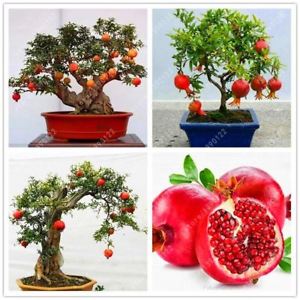
Nana
The tree grows up to 1 m high. The leaves are small, oval in shape. Flowers are crimson in color. Fruits size 3-5 cm. Blooms pomegranate in the second year of life.
Alba
Pomegranate can grow up to 3 m, but by pruning it is given a compact shape. The leaves are dark green, glossy, slightly elongated. It blooms, starting from the second year of life, with large white or double cream flowers up to 6 cm in size. The variety is decorative, does not bear fruit.
Baby
Miniature plant, needs artificial pollination. Height – up to 50 cm. Small elongated castings grow evenly along the length of the branch. It begins to bloom at 3-4 years of age. The flowers are terracotta or red, single or collected in bunches of 5-7 pieces. The fruits are brownish-yellow in color, average size is 3 cm.
Carthage
Plant height is up to 80 cm. Flowering begins 6-8 years after planting the seed. The flowers are red, about 4 cm in size. Fruits are up to 6 cm.
Ruby
The height of the tree is about 70 cm.Flowers deep ruby color. The fruits reach a size of 6-8 cm and a weight of up to 100 g.
What does the plant look like?
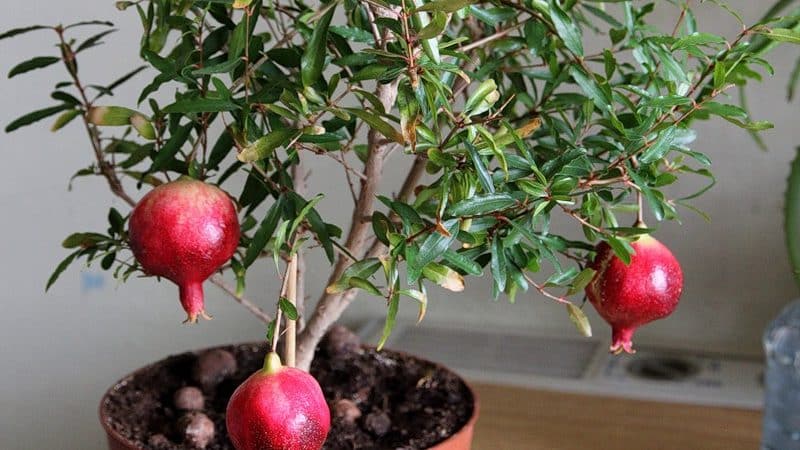
Dwarf pomegranate is a compact plant up to 1 m high. It produces original bonsai 25-30 cm in size. The leaves are green, glossy, elongated. Flowers in burgundy shades.
Distinctive characteristics:
- The first flowering occurs 3-4 months after planting.
- Early fruiting. On a two-year-old plant, up to a dozen pomegranates with a diameter of 3-5 cm are formed. The fruits are edible.
- Preserves foliage for the winter.
- Easy to care for.
How to grow a pomegranate tree at home
At home, pomegranate is grown from seeds and seeds, propagated by cuttings and through vaccination.
Growing from a seed taken independently
The advantage of this method is its high decorative effect.
The disadvantage is that there is no fruiting.
The recommended time for planting seeds is late February - early March. The best option for planting is fresh seeds of ripe and healthy fruit, for example, a ripened indoor pomegranate. The pulled out bones are cleared of pulp.
Reference. If you do not wash off the pulp, it will rot and destroy the sprout.
The color of seeds suitable for sowing is cream. They should feel firm to the touch. Both a universal soil mixture and soil for citrus fruits are suitable as a substrate.
How to grow pomegranate from a seed:
- the prepared seeds are planted in the soil to a depth of 1-1.5 cm;
- after planting, water, cover the top with glass or film and place in a sunny place;
- aftercare: ventilation, spraying;
- After the true leaves appear, the sprouts are transplanted into separate pots, shortening the root by a third.
From purchased seeds
When purchasing pomegranate seeds, it is recommended to pay attention to the expiration date. Fresh seeds have the best germination rate - 65-95%.
Preparation consists of treating the seeds with a growth stimulant, for example, Epin Extra.
Procedure for growing pomegranate tree from seeds:
- seeds are buried in moist soil by 0.5-1 cm with a distance of up to 4 cm from each other;
- cover the container with film and ventilate regularly;
- seedlings are sprayed with water daily;
- the first shoots appear after 14-20 days;
- The plants are transplanted into a separate container after 3-4 months, when the sprouts have 4-5 full leaves.
Flowering and fruiting occurs 5-8 years after planting.
Reference. A plant from seed rarely inherits all the characteristics of the parent variety. To definitely get a beautiful and fruit-bearing pomegranate, propagate it vegetatively - by cuttings.
Propagation by cuttings
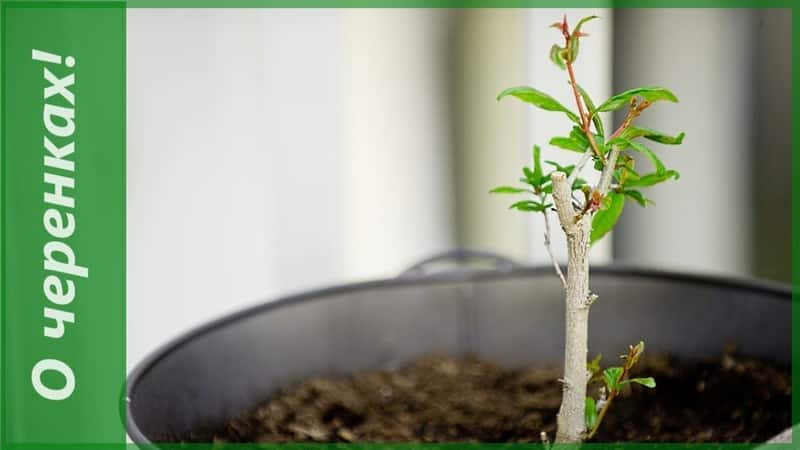
Advantages of the method:
- pomegranate retains the characteristics of the mother plant - immunity to disease, ability to flower and bear fruit;
- flowering in the second year.
The disadvantage is that cuttings take a long time to root and not all of them take root, so it is recommended to use several at once.
Summer crown pruning and pomegranate propagation are often combined, since seedlings take root better in summer than in winter. Lignified shoots 10-15 cm long with 5-7 well-developed buds are suitable as cuttings.
Cutting procedure:
- an oblique cut is made on the cutting and the cut edge is treated with a growth stimulator, for example, Epin Extra, Zircon;
- prepared cuttings are buried in moist soil 3 cm at an angle at a distance of up to 10 cm from each other;
- The seedlings are covered with a cut plastic bottle on top and placed in a warm, well-lit place;
- care consists of ventilation and spraying, the soil should be moist;
- rooting of cuttings lasts up to two months;
- They are transplanted into separate pots when new leaves appear.
Graft
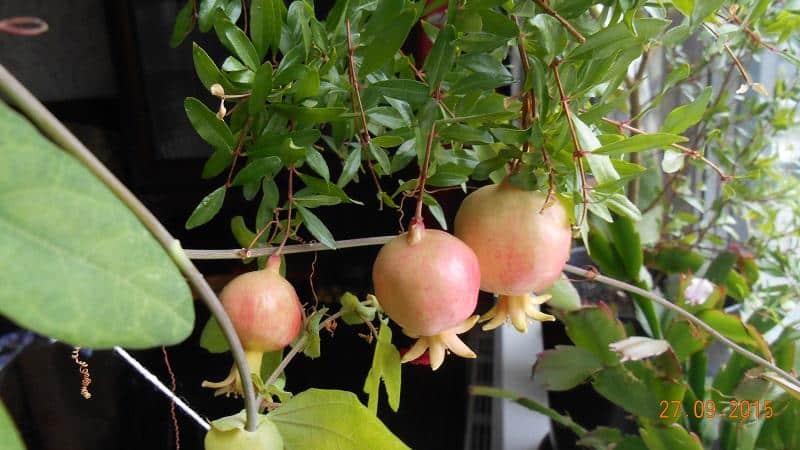
This is another way to propagate pomegranate trees. The plant is grafted in the spring. This requires:
- rootstock - a tree grown from a seed;
- scion – a varietal cutting from a fruit-bearing plant.
Vaccination is carried out in the following ways:
- Simple copying. The procedure is carried out in the second year of growing the tree. As a cutting, take a twig 5 cm long with four developed buds. The rootstock and scion should have the same thickness; oblique cuts of about 3 cm are made on them and tightly connected to each other. This place is treated with garden varnish and secured with electrical tape until complete merging.
- In the side cut. In this case, the scion is thinner than the rootstock. The rootstock branch is split from the side and a cutting is inserted, in the lower part of which a wedge was previously made with two cuts. The connection point is fixed with electrical tape.
- Into the cleft The scion is taken of the same thickness as the rootstock, and a wedge is formed at the end by cutting. The rootstock is trimmed, leaving up to 30 cm of the main stem, and split in the middle. A scion is placed in the split, the junction is treated with varnish and wrapped with electrical tape.
After grafting, the tree will bloom after 3-4 years.
Flowering and fruiting of indoor varieties

Pomegranate grown at home begins to bloom at least three years after planting, it depends on the method of propagation. At the same time, the plant contains buds, ovaries, and fruits.
Flowering is long, from mid-spring to late summer, abundant, beautiful, represented by large orange-red flowers. Flowers vary in shape and ability to produce fruit:
- Elongated bell-shaped, not forming fruits (male). Most flowers belong to this type. They appear in large numbers in the second year of cultivation; they are characterized by short flowering - they open and fall off after 2-3 days.
- Jug-shaped (female). This is the fertile type. They tend to bloom for up to 10 days. Afterwards, small round fruits of brown-red color with numerous edible grains are formed from the ovary.
In the first year of flowering, it is recommended to remove all ovaries; the next year, leave 2-3 fruits, since these processes take a lot of energy from the plant.
Features of caring for decorative pomegranate at home
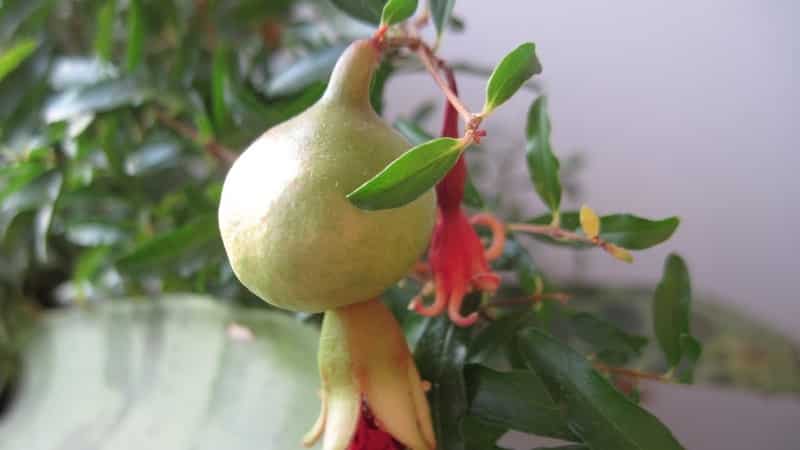
Pomegranate is unpretentious. For full growth and development, the plant requires certain conditions and care.
Transfer
Pomegranate is replanted in late February - early March. The procedure is carried out carefully and carefully so as not to damage the root system. If the root is damaged, it is removed, and the cut site is treated with crushed coal.
Young plants are replanted every year, trees older than three years - as they grow out of the pot, approximately every four years. Each subsequent pot should be 2 cm larger in diameter than the previous one.
Reference. Large perennial pomegranate trees are not replanted, but about 5 cm of the top layer of soil is replaced.
Suitable pot
The choice of container volume depends on the height and age of the pomegranate tree. Initially, a 100 ml pot is sufficient.
Important! A tight container promotes the formation of fewer infertile flowers.
For adult plants, pots from 500 ml are suitable, proportional to their root system.
Lighting
Pomegranate loves bright sun. For successful growing season, it is placed in a well-lit place. In spring and summer, the pot is placed in open sunny areas with slight shading. With the onset of cold weather, the plant is returned to a room with sufficient lighting.
Humidity
Air humidity is required to be moderate, about 65%. At low temperatures, spray the plant with cool water and wipe the foliage with a damp cloth. You can also increase the indicator by placing a container of water next to the pot. High humidity is balanced with frequent ventilation.
Temperature
Comfortable conditions for the plant in the summer are open air and temperatures within +18...+25°C. In winter, pomegranate is kept in a cool room with a temperature of +10...+12°C. In the spring, when the frosts have passed, it is taken out to the balcony or garden.
Priming
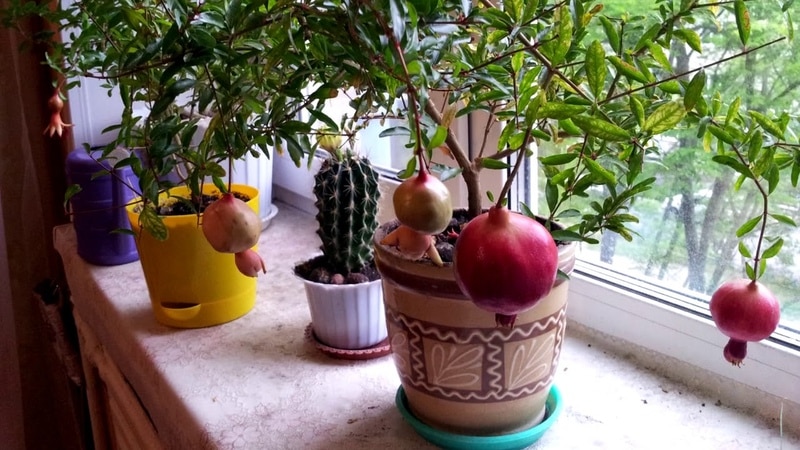
Pomegranate is unpretentious to soil maintenance. Basic conditions: nutritional value, saturation with minerals and organic substances, water permeability. For planting, use universal soil or a mixture of turf, leaf and sand-peat substrate in a ratio of 2:1:1:1.
Watering
During the active growing season, the plant requires abundant watering every 3-4 days. When fruits appear on the branches, water the pomegranate without allowing the soil to dry out to avoid cracking of the ovaries.
During the dormant period, the frequency of watering is reduced to once every two weeks, but the soil should also not dry out completely. Soil moisture is maintained by loosening or spraying.
Water at the root, avoiding water getting on the foliage, and only from above, since the plant has a superficial root system.
Feeding
Feed the tree in the spring-summer period once every two weeks with universal liquid fertilizer for indoor plants.. Also as feeding use potassium-phosphorus fertilizers and nitrogen additives (“Agro Gumat”, “Autumn”).
To obtain the harvest, organic additives are used: a solution of chicken manure (filled with water in a ratio of 1:2, after 15-20 days diluted with water 1:25 and before application diluted with water 3:4) or mullein infusion (1 part to 10 parts of water). Also, during watering, the tree is fed with an aqueous solution of wood ash (1 part ash and 10 parts water).
With the beginning of autumn, feeding is stopped.
Spraying
Pomegranate needs to be sprayed in dry conditions at temperatures above +28°C and when exposed to open sun. In winter, spraying is not required; normal air humidity is sufficient.
Pruning and crown formation
The pomegranate tree is pruned before the beginning of the growing season, in February. Dried flowers and leaves are also removed regularly.
Pruning helps preserve the plant's strength for abundant flowering and fruiting. Shearing rejuvenates the plant and stimulates branching.
To form a decorative crown, the shoots of the tree are pinched, trimmed, and bent to the ground using wire. A spherical crown is created by cutting off excess trunks and lower branches at a height of approximately 15 cm from the ground surface. To obtain a lush bush, periodically pinch the tips of all shoots without removing the lower branches.
Disease and pest control

- Branch cancer represents cracking of the bark and swelling of wounds. This subsequently leads to the drying out of the entire tree. At the first stage, washing the wounds, spraying them with copper sulfate and treating them with garden pitch helps.If the entire tree is affected, it is cut down.
- In the fight against gray mold It helps to introduce a preparation based on trichodermin into the soil and spray it with Thirama solution (TMTD).
- From cancer of the roots get rid of by replanting the plant and removing growths. Wounds are treated with garden varnish.
- Aphids are dangerous for pomegranate trees. To combat it, use a two-day infusion of tobacco (40 g per 1 liter of hot water). Before spraying, it is mixed with water in a ratio of 1:2 and with 4 g of crushed laundry soap.
- Get rid of spider mites, whiteflies and scale insects A five-day onion or garlic solution (20 g of husk per 1 liter of water) helps. Also, acaricidal agents (Fitoverm, Actellik) are used in the fight against spider mites.
- To destroy the codling moth All affected fruits must be removed.
- From mealybugs are eliminated by spraying the plant with Mospilan or Aktara. The procedure is carried out three times with an interval of five days.
Conclusion
Dwarf pomegranate is suitable for growing at home from seed, by rooting cuttings or grafting. The inherent characteristics allow the plant to bear fruit, the conditions and rules of cultivation are easily achievable, and the methods of propagation are varied.